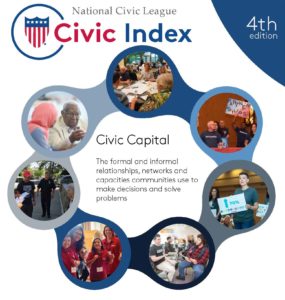By Doug Linkhart — President, National Civic League
 What makes some communities better able than others to solve the tough social, political, economic or physical challenges they face? This was a question the National Civic League set out to answer over 30 years ago. On-the-ground research revealed a set of factors that we call civic capital — the formal and informal relationships, networks and capacities that communities use to make decisions collaboratively and solve problems.
What makes some communities better able than others to solve the tough social, political, economic or physical challenges they face? This was a question the National Civic League set out to answer over 30 years ago. On-the-ground research revealed a set of factors that we call civic capital — the formal and informal relationships, networks and capacities that communities use to make decisions collaboratively and solve problems.
Somewhat like social capital, but not to be confused with financial capital, civic capital can be found in all sorts of communities, not just the most affluent, educated or advantaged. While myriad other factors contribute to community progress, civic capital is the core factor identified by the National Civic League as the primary explanation for long-term community success.
At the National Civic League, we know of many communities with an abundant supply of civic capital. The All-America City program has recognized over 500 of these communities during the past 69 years. All have varying degrees of civic engagement, collaboration and leadership, and have been able to tackle tough issues in a sustainable manner–by bringing everyone to the table and creating equity.
Earlier this year the National Civic League released the fourth edition of the Civic Index, a self-assessment tool consisting of a set of questions that provide a framework for discussing and measuring a community’s civic capital. Since it was first developed in 1986, many communities have used the Civic Index to better understand their civic strengths and to identify gaps or areas in need of further attention, soliciting community input to create a baseline measure of their civic capital and monitor progress over time as they work to enhance their internal capacity.
The Seven Components of Civic Capital
The Civic Index describes the seven components of civic capital, provides examples of each, lists the 32 questions that are used to gauge each component and provides ideas on how to use the index. Here’s a synopsis of these seven components.
- Engaged Residents: Residents play an active role in making decisions and civic affairs.
- Inclusive Community Leadership: The community actively cultivates and supports leaders from diverse backgrounds and with diverse perspectives
- Collaborative Institutions: Communities with good civic capital have regular collaboration among the government, business, nonprofit and other sectors, as well as structures in place that facilitate such collaboration.
- Embracing Diversity and Equity: Communities with healthy civic capital recognize and celebrate their diversity. They strive for equity in services, support and engagement.
- Authentic Communication: Healthy communities need credible, civic-minded sources of information presented in a way that residents can use.
- Culture of Engagement: Involvement by residents, businesses, nonprofits and other stakeholders in every aspect of civic affairs should be part of local culture—an expectation, not an afterthought.
- Shared Vision and Values: Communities with shared values and civic pride have a common foundation for addressing public matters.
Summary
Nearly a hundred years ago, Justice Louis Brandeis, a one-time member of the League’s executive committee, called states “laboratories of democracy.” That mantle has now been passed to the local level, as cities, counties, towns and other local communities create innovations and regional or national networks to tackle such issues as climate change, health, education and economic prosperity.
At the same time, local governments cannot solve problems on their own. As Bruce Katz points out in The New Localism, community problem-solving depends on “multi-sectoral relationships,” with government often serving as a convener or catalyst. What happens next depends on the civic capacity of the particular locality. It is the communities with civic capital — the full engagement and collaboration of its residents, businesses, nonprofits and other stakeholders–that have the resources and persistence to successfully address difficult issues and build a sustainable future.
For a free copy of the National Civic League’s Civic Index, please visit www.nationalcivicleague.org/resource-center.



